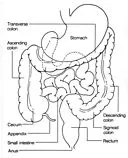
Sixty of the patients had significant injuries, such as perforation or mesenteric injury with resulting dead bowel tissue. This group accounted for more than 7 percent of the people who had a celiotomy during the same time period. All injuries except for one were diagnosed through the use of peritoneal lavage. Only two people had duodenal injuries. The small bowel often had perforations along the entire course. Colon injuries made up a fourth of all blunt trauma to bowel, mostly occurring in the ascending colon and the sigmoid colon. Of this group, 16 people died. Six of the deaths were directly related to their bowel injury.
Among blunt trauma patients, 5 percent are detected at the time of a laparotomy. CT scan is sometimes used to detect bowel injuries and is now how blunt trauma is detected. Doctors use contrast material, looking for extravasation of blood from the mesenteric arteries or perforations of the Gl tract itself. Using the vascular contrast, one can see stoppage of blood flow in ischemic areas of the mesentery or colon. There can be thickening of damaged bowel wall or fluid in the retroperitoneal space. Sometimes it pays to wait a few hours as long as the patient is stable to have some of the changes show up better on CT scan.
Bowel injuries are the most common blunt trauma to the abdomen. Direct force crushes the gastrointestinal tract and the rapid deceleration seen in motor vehicle accidents causes shear forces in colonic and small bowel tissue. Sudden changes in the pressure within the abdomen can cause a type of bursting injury seen only in blunt trauma.
Commonly injured small bowel areas are the proximal jejunum near the ligament of Treitz, and near the ileocecal valve.
It’s important to diagnose a blunt force trauma to the intestinal contents as soon as possible as a delay can result in increased morbidity or even mortality. Death can happen secondary to peritonitis or due to excessive bleeding. The peritonitis can lead to sepsis and death. The symptoms, unfortunately, are very vague in the beginning and can simply be mild abdominal pain, leading to severe abdominal pain, fever and leukocytosis. The use of these clinical assessment tools can lead to a negative laparotomy up to 40 percent of the time. It’s apparent that something needs to be done, such as a CT scan, in order to determine the probability of major trauma to the bowel.
A peritoneal lavage is another test for the presence of trauma to the abdominal contents. In this test, an amount of fluid is placed into the abdominal cavity, allowed to swish around a bit and then is extracted from the abdomen. The presence of blood in the fluid (hemoperitoneum) is 90 percent sensitive for detecting a problem. If the peritoneal lavage is done too soon after the injury, up to ten percent of tests can be falsely negative. Whenever possible, the CT scan should be done before the peritoneal lavage so that fluid and blood don’t interfere with the CT scan.
An ultrasound can also be done. It is 86 percent sensitive and 98 percent specific when it comes to detecting the presence of an abnormal amount of fluid in the abdomen. This test isn’t considered as good as a CT scan of the abdomen so that it isn’t used as much.
Should you or someone you know, need legal advice regarding abdominal injuries resulting from blunt trauma, please contact Edward A Smith Law Offices for free friendly advice.
Illustration: By Unknown Illustrator [Public domain], via Wikimedia Commons
